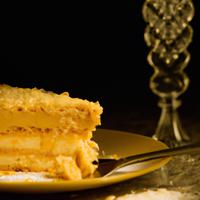
1 serving (80 grams) contains 239 calories, 2.7 grams of protein, 9.9 grams of fat, and 36.5 grams of carbohydrates.

Log this food in SnapCalorie

Nutrition Information
Calories |
702.9 | ||
|---|---|---|---|
% Daily Value* |
|||
| Total Fat | 29.1 g | 37% | |
| Saturated Fat | 7.4 g | 37% | |
| Polyunsaturated Fat | 0 g | ||
| Cholesterol | 102.9 mg | 34% | |
| Sodium | 670.6 mg | 29% | |
| Total Carbohydrates | 107.4 g | 39% | |
| Dietary Fiber | 1.5 g | 5% | |
| Sugars | 75 g | ||
| protein | 7.9 g | 15% | |
| Vitamin D | 0 mcg | 0% | |
| Calcium | 147.1 mg | 11% | |
| Iron | 3.5 mg | 19% | |
| Potassium | 205.9 mg | 4% | |
* Percent Daily Values are based on a 2,000 calorie diet. Your daily values may be higher or lower depending on your calorie needs.
Food Attributes
Source of Calories
About Slice of yellow cake
Slice of yellow cake is a classic dessert with roots in American baking traditions. This sweet treat is made primarily from flour, sugar, eggs, butter, and milk, with vanilla extract often adding its signature flavor. Yellow cake gets its name and rich color from the use of egg yolks and butter in the batter. While beloved for its soft, fluffy texture, it is typically high in sugar and saturated fats, making it an indulgent choice rather than a health-focused option. Depending on preparation, it may also be topped with frosting, adding to its calorie content. Though not particularly nutritious, it can offer a small source of energy due to carbohydrates. For a healthier twist, some recipes incorporate whole-grain flour or alternative sweeteners. Best enjoyed in moderation, yellow cake remains a nostalgic and celebratory favorite for birthdays, special occasions, or casual treats.



